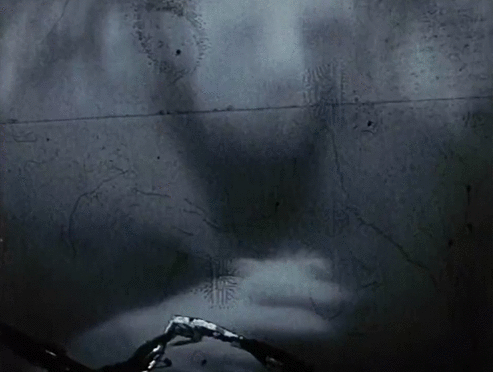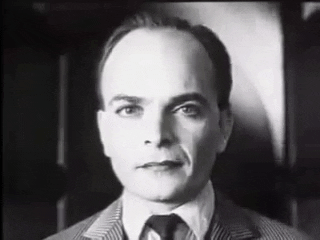“Shadow boxes become poetic theaters or settings wherein are metamorphosed the element of a childhood pastime.”Children's Party (Joseph Cornell, c. 1938/1969)
Dec
18
Las Posadas
.png)
Exuberant dancers at the children's party.
A festive child for Las Posadas
– Joseph Cornell
Children of all ages are entertained by a menagerie of dancers, acrobats, talented fauna and bobbing apples in this exhilarating found-footage party. Part of The Children's Trilogy, together with Cotillion (c. 1938/1969) and The Midnight Party (c. 1938/1969).
FoundFootage
“Well, as I said before, I say again, here's… Here's to a son… to the house of Frankenstein.” Frank Stein (Iván Zulueta, 1972)
Oct
30
Karloff

The Monster (Karloff) in Zulueta's recut (via). DP: Iván Zulueta / Arthur Edeson + Paul Ivano.
A [favourite] Boris Karloff film*
– Baron Frankenstein
Zulueta's mycotoxic fever dream of Whale's Frankenstein.
* the Bales 2025 Film Challenge for October is horror-themed as opposed to date-based, and is all about favourites. Expect non-horror and films I believe to be relevant instead.
“A premonition of a horror film” Outer Space (Peter Tscherkassky, 1999)
Oct
26

Barbara Hershey as Carla Moran. DP of The Entity: Stephen H. Burum.
[Favourite] psychological horror*
– tagline
Real horror is not found in broken dinner plates or corpuscular masses of light. It's in what the mind does with that input, in how those lux morph into human-like shapes. In how gusts of wind becomes larynx-touched voices. Cut up the neatly filed research papers and be left with the whispers of the mind.
* the Bales 2025 Film Challenge for October is horror-themed as opposed to date-based, and is all about favourites. Expect non-horror and films I believe to be relevant instead.
“When we began to compare the typically American, typically European, and typically Russian films, we noticed that they were distinctly different from one another in their construction. We noticed that in a particular sequence of a Russian film there were, say, ten to fifteen splices, ten to fifteen different set-ups. In the European film there might be twenty to thirty such set-ups (one must not forget that this description pertains to the year 1916), while in the American film there would be from eighty, sometimes upward to a hundred, separate shots. The American films took first place in eliciting reactions from the audience; European films took second; and the Russian films, third. We became particularly intrigued by this, but in the beginning we did not understand it.” Эффект Кулешова [Kuleshov Effect] (Lev Kuleshov, 1918)
Aug
5

A closeup of a man, followed by a medium shot of a child in a coffin, then back to the man. Can you see how his expression changes? (via). DP: to be determined.
Celebrating Dia de Los Muertos [on November 1 and 2, of course]: a cemetery, coffin, or dead person*
– Lev Kuleshov, The Principles of Montage, from The Practice of Film Direction (pp. 183-195) (source)
Director Lev Kuleshov explains what happens when a scene is followed by a reaction shot. Depending on the preceding image, the viewer projects an emotion onto the performer's facial expression. In his most famous montage, made up of existing footage – because property is theft, we see matinee idol Ivan Mosjoukine “react” to a bowl of soup, a little girl in a coffin, and a woman sprawled out on a divan.
* the Bales 2025 Film Challenge for August is not date-related but lists, for the most part, the colours of the rainbow.
“Parfois ils disent que nos images sont esthétiques, mais nous disons que les images esthétiques sont des images hautement étiques. Pour nous éthique et esthétique marchent ensemble. Re-filmer signifie re-signifier.”Prigionieri della guerra [Prisoners of War] (Yervant Gianikian + Angela Ricci Lucchi, 1995)
Apr
24
Armenian genocide

Horse-pulled carts arrive at a cross (via). DPs: Yervant Gianikian & Angela Ricci Lucchi.
A World War I film: a day in recognition of the forced deportations and genocide in Armenia, 1915 — 1923.
– Yervant Gianikian and Angela Ricci Lucchi in conversation with Daniele Dottorini, 2007 (via)
Re-purposed propaganda reels show citizens – displaced, dehumanised – turned into prisoners of war, and finally into corpses.
“The film is about observing, about glances that see without being seen, a dubious art of light and visibility.”Der Riese [The Giant] (Michael Klier, 1983/1984)
Feb
15
freebie: a movie from 1984

A woman, we only see her hands, waits at a counter while clutching her purse. Her handbag is next to her. The camera focusses on the small space reserved to count out money. DP: n/a.
January 21 redux: a film from 1984 on the date Orwell died (1950).
– Michael Klier, via
According to Harun Farocki, Der Riese was the first narrative film completely compiled out of surveillance footage.